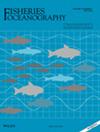Bigeye tuna (Thunnus obesus; BET) and yellowfin tuna (Thunnus albacares; YFT) are commercially and ecologically important Atlantic Ocean species. Numerous studies have examined interacting species with clearly synchronous or asynchronous dynamics, but few have investigated interactions among tuna species. This study investigated the effects of climate indices on the standardized catch per unit effort (CPUE) and habitat preferences of BET and YFT in the Atlantic Ocean. The indicators for both tuna species were found to be influenced by the Atlantic Multidecadal Oscillation (AMO) and Tropical North Atlantic index. The AMO had the strongest effect on standardized CPUE for the two species, and habitat suitability also reflected AMO trends. We compared CPUE trends in overlapping suitable habitat areas and estimated variations in primary prey abundance for between BET and YFT to evaluate their species' competition for limited prey and habitat area resources. The standardized CPUE, habitat suitability index (HSI), and primary prey levels (squid and crustaceans) of BET all increased following the change to the positive AMO phase after the 1990s. Although the HSI value for YFT also increased in an area of habitat overlap, the corresponding standardized CPUE decreased. We suggest that this pattern of a decreasing-standardized CPUE for YFT may have been caused by competition for limited prey and habitat area resources in the overlap area.


